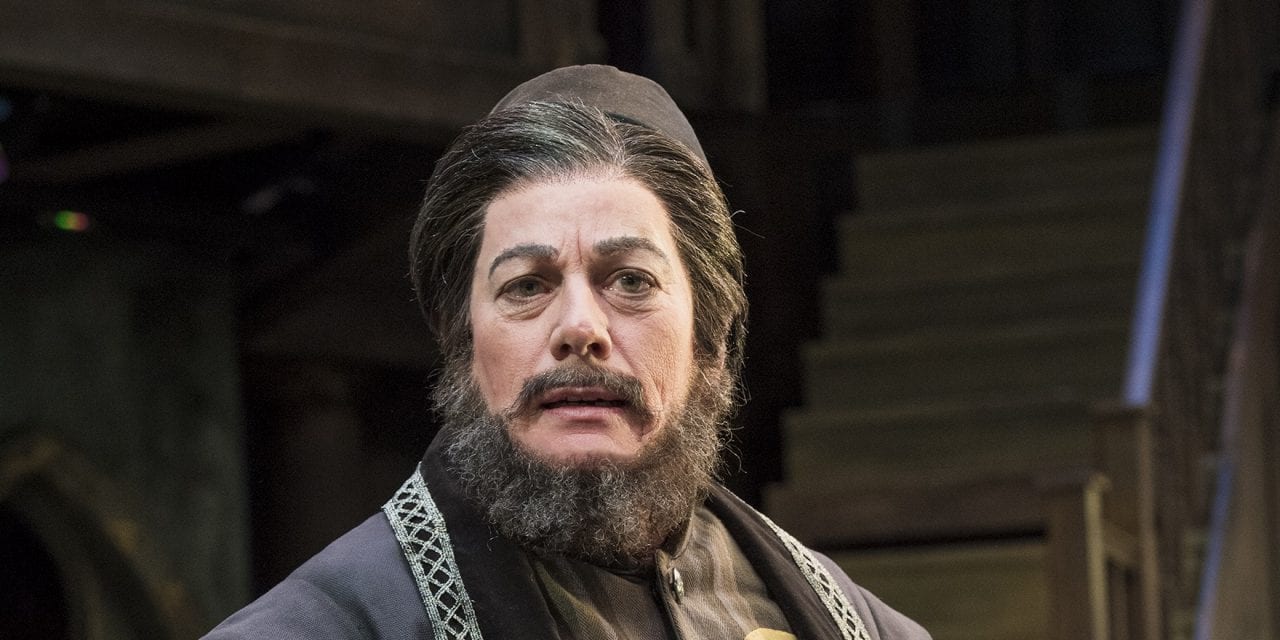CEDAR CITY — Shakespeare‘s sermon on mercy and forgiveness, The Merchant of Venice, has returned to the Utah Shakespeare Festival in a production that mixes traditional techniques with new choices. The result is a production that is thought-provoking, though not without reservations.

Show closes September 7, 2018.
The Merchant of Venice tells the story of the Jewish merchant Shylock, who enters a contract to lend money to fellow businessman Antonio. When the contract expires after three months, Antonio must either repay the debt he owes Shylock with 3,000 ducats or a pound of Antonio’s flesh. When Antonio’s business ventures fail, he is unable to repay the money, and Shylock demands his morbid recompense. Meanwhile, Shylock’s daughter, Jessica, is in love with a Christian named Lorenzo, and Antonio’s friend Bassanio attempts to woo and marry the wealthy Portia.
Director Melinda Pfundstein took the somewhat unconventional approach of casting four women in five male roles in the play: Antonio (played by Leslie Brott), Shylock (played by Lisa Wolpe), Lancelet Gobbo (played by Isabella Abel-Suarez), the Duke of Venice, and Tubal (both of the latter two played by Tracie Lane). The decision varies in its degree of success; Wolpe is completely convincing as a man. (Were her name not in the program, I would not have known that a woman was playing Shylock.) Brott nearly so, though her voice was too high to sound like a man’s. As a Shakespearean clown, gender did not matter much for Abel-Suarez’s role, as long as she appears silly and unsophisticated, which she did. The least convincing performance was from Lane, though her two roles are on stage for such a brief time that it did not impact my enjoyment of the play much.

Lisa Wolpe as Shylock. (Photo by Karl Hugh. Copyright Utah Shakespeare Festival 2018.)
But what of having women in these roles at all? Female performers have been playing major male Shakespeare roles for over a century, and women often play Prospero, Ariel, and Puck. (I have seen more women play King Lear and his fool than I have seen men in the roles.) There is no logical reason why some Shakespeare roles cannot be frequently played by women or that others should be closed to female performers. All the women in The Merchant of Venice are capable of playing their roles. Whether the casting decision works or not depends far more on whether an audience member is open to an unconventional casting choice than about anything on stage. As Portia says, “God made him, and therefore let him pass for a man.”
As Antonio, Brott is dignified and authoritative in her scenes, especially when she interacts with Bassanio (played by Wayne T. Carr). Their relationship is almost familial, and the devotion that each shows towards the other mirrors a believable mentor-mentee relationship. Brott’s performance turns poignant as Antonio realizes that he must face his reckoning and give up a pound of flesh. Her heavy gestures and mournful face made me feel for Antonio.

Leslie Brott as Antonio. (Photo by Karl Hugh. Copyright Utah Shakespeare Festival 2018.)
Wolpe’s Shylock is cunning and bitter. She was absolutely riveting in the “If you prick us, do we not bleed?” monologue. Her Shylock also had believable roots for his cruelty, and when he explained that the Christians of Venice were cruel to him first, I found his bitterness towards Antonio and his friends completely rational. The only drawback with Wolpe’s performance is her accent, which seemed vaguely Eastern European. The effect was to make Shylock seem more of a negative Jewish stereotype than a real person, an unfortunate dimension to a play that already has an anti-Semitic reputation. (Yes, Shylock is called an “alien” in the legal sense in the play, but his Jewishness is enough to mark him off as being different from the Venetians.)
I cannot praise Wayne T. Carr enough as Bassanio. Carr has a thorough mastery of the poetry of Shakespeare’s text, and as he speaks, the 400-year-old text seems to flow from him without betraying a hint of difficulty. Carr imbues Bassanio with the devotion needed for him to do everything possible to help Antonio avoid his fate. I also enjoyed the romantic relationship that Bassanio and Portia developed, and when Bassanio and Gratiano (played by Josh Innerst) said to their fiancées that they had given away their betrothal rings, Carr’s reactions supplied much of the scenes comic relief.

Wayne T. Carr (left) as Bassanio and Tarah Flanagan as Portia. (Photo by Karl Hugh. Copyright Utah Shakespeare Festival 2018.)
The women playing the three named female roles in The Merchant of Venice were all entrancing, and it was easy to see why Bassanio, Gratiano, and Lorenzo would fall in love with Portia, Nerissa, and Jessica, respectively. As Portia, Tarah Flanagan was regal in her bearing, which made the stream of princes who sought her as a wife plausible. Flanagan showed Portia as a woman accustomed to being in control of her surroundings, which made her anxiousness when suitors would choose a casket a fascinating insight into Portia’s psychology. I also enjoyed the banter between Portia and Nerissa (played by Betsy Mugavero), her “waiting gentlewoman.” The female bond between the two felt so real that watching them talk about Portia’s parade of suitors felt almost voyeuristic. Finally, Aidaa Peerzada could not possibly improve her performance as Jessica. Peerzada gave her character the fortitude that Jessica would need to face rebelling against her father and then dealing with the pain of his punishment.
Bill Black‘s costumes for every performer were flattering and eye-catching. I will never tire of the detailed and splendid Renaissance costumes that the Utah Shakespeare Festival often creates for their Shakespeare productions. The carnival costumes for the opening of the play were effective in establishing the Italian setting, and I enjoyed the flowing gowns on the women and the smart the waistcoats for the men. The set design (by Apollo Mark Weaver) was also pleasing, with the upstage area of the Englestad Theater decorated with blue gothic arches. However, Weaver also added a sheer lavender cloth that could be pulled like a curtain across the upstage wall to show that a scene was taking place indoors. The sound of the curtain traveling in its metal track between scenes was distractingly modern. Plus, the curtain was largely unnecessary because Shakespeare—having no scenery in his theaters—used verbal cues to tell the audience where a scene was occurring.
Apart from the casting decisions, there is much to discuss about Pfundstein’s direction. One particular nice touch was to add two singers (Keaton Delmar Johns and Courtney McMullin), whose haunting voices often gave the show an unworldly, regretful feel (especially when Shylock exits the courtroom). But Pfundstein could also create lighthearted moments in the play, such as during Lorenzo and Jessica’s dance in the fifth act (with the help of movement director Megan Brunsvold Mercedes) and in the Prince of Arragon’s scene in Portia’s home.
However, I disagreed with Pfundstein’s decision to show Shylock’s forced conversion to Christianity on the balcony simultaneously with the dialogue of the final scene. The upstage scene was distracting, and to watch Shylock’s shame continue after he had been humiliated in the courtroom scene seemed unnecessary. Giving the audience one last look at a defeated Shylock is not an unusual directorial choice, and I confess that it adds to the tragedy of the title character.
There is merit in this year’s production of The Merchant of Venice at the Utah Shakespeare Festival. Pfundstein has created a production that works on its own terms, largely thanks to the talented cast. I expect audience reactions, though, to be divided. That’s not unexpected, though, for a tricky play that has provoked conversation for centuries.
Donate to Utah Theatre Bloggers Association today and help support theatre criticism in Utah. Our staff work hard to be an independent voice in our arts community. Currently, our goal is to pay our reviewers and editors. UTBA is a non-profit organization, and your donation is fully tax deductible.


![[TITLE OF SHOW] is theatre of the people, by the people, for the people](https://utahtheatrebloggers.com/wp-content/uploads/2014/11/title-of-show-logo-Utah-Repertory-Theater-Company.jpg)


